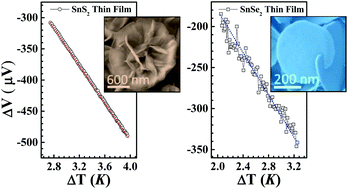Our official English website, www.x-mol.net, welcomes your feedback! (Note: you will need to create a separate account there.)
Controllable colloidal synthesis of anisotropic tin dichalcogenide nanocrystals for thin film thermoelectrics†
Nanoscale ( IF 6.7 ) Pub Date : 2018-01-10 00:00:00 , DOI: 10.1039/c7nr08387d Deqiang Yin 1, 2, 3, 4 , Yang Liu 1, 2, 3, 4 , Chaochao Dun 4, 5, 6, 7, 8 , David L. Carroll 4, 5, 6, 7, 8 , Mark T. Swihart 1, 2, 3, 4
Nanoscale ( IF 6.7 ) Pub Date : 2018-01-10 00:00:00 , DOI: 10.1039/c7nr08387d Deqiang Yin 1, 2, 3, 4 , Yang Liu 1, 2, 3, 4 , Chaochao Dun 4, 5, 6, 7, 8 , David L. Carroll 4, 5, 6, 7, 8 , Mark T. Swihart 1, 2, 3, 4
Affiliation

|
Tin chalcogenides have shown promise in applications including energy storage, optoelectronics, photovoltaics, and thermoelectrics. Here, we present a colloidal synthesis strategy to produce tin dichalcogenide nanocrystals (NCs) with controllable stoichiometry, vacancies, shape, and crystal structure. Compared with previously reported methods, we use less expensive precursors, such as tin(IV) chloride and sulfur or selenium powder, to produce tin(IV) chalcogenide NCs. SnS2 and SnSe2 NCs with novel NC morphologies including SnS2 nanoflowers/nanoflakes, SnSe2 nanosheets with circular and hexagonal shapes, as well as mixtures of nanospheres and nanoflakes were prepared by varying the solvents and anion precursors. We were also able to reduce tin(IV) to tin(II) to produce tin(II) chalcogenide NCs. The corresponding thin films were prepared by spin-coating, followed by post-treatment to study their thermoelectric properties. Room temperature Seebeck coefficients of −150 μV K−1 and −126 μV K−1 were measured for SnS2 and SnSe2 films, demonstrating their promise as thin film thermoelectric materials.
中文翻译:

用于薄膜热电学的各向异性二硫化锡锡纳米晶体的可控胶体合成†
硫族锡化物已在包括储能,光电,光伏和热电在内的应用中显示出了希望。在这里,我们提出了一种胶体合成策略,以生产具有可控化学计量,空位,形状和晶体结构的二硫化锡锡纳米晶体(NC)。与以前报道的方法相比,我们使用价格更便宜的前体,例如氯化锡(IV)和硫或硒粉,来生产锡(IV)硫族化物NC。具有新颖NC形态的SnS 2和SnSe 2 NC,包括SnS 2纳米花/纳米鳞片,SnSe 2通过改变溶剂和阴离子前体制备了具有圆形和六边形形状的纳米片,以及纳米球和纳米薄片的混合物。我们还能够将锡(IV)还原为锡(II)以生产锡(II)硫族化物NC。通过旋涂制备相应的薄膜,然后进行后处理以研究其热电性能。室温-150塞贝克μV的K系数-1和-126μVķ -1测量了的SnS 2和位SnSe 2层薄膜,证明它们作为薄膜热电材料承诺。
更新日期:2018-01-10
中文翻译:

用于薄膜热电学的各向异性二硫化锡锡纳米晶体的可控胶体合成†
硫族锡化物已在包括储能,光电,光伏和热电在内的应用中显示出了希望。在这里,我们提出了一种胶体合成策略,以生产具有可控化学计量,空位,形状和晶体结构的二硫化锡锡纳米晶体(NC)。与以前报道的方法相比,我们使用价格更便宜的前体,例如氯化锡(IV)和硫或硒粉,来生产锡(IV)硫族化物NC。具有新颖NC形态的SnS 2和SnSe 2 NC,包括SnS 2纳米花/纳米鳞片,SnSe 2通过改变溶剂和阴离子前体制备了具有圆形和六边形形状的纳米片,以及纳米球和纳米薄片的混合物。我们还能够将锡(IV)还原为锡(II)以生产锡(II)硫族化物NC。通过旋涂制备相应的薄膜,然后进行后处理以研究其热电性能。室温-150塞贝克μV的K系数-1和-126μVķ -1测量了的SnS 2和位SnSe 2层薄膜,证明它们作为薄膜热电材料承诺。


























 京公网安备 11010802027423号
京公网安备 11010802027423号